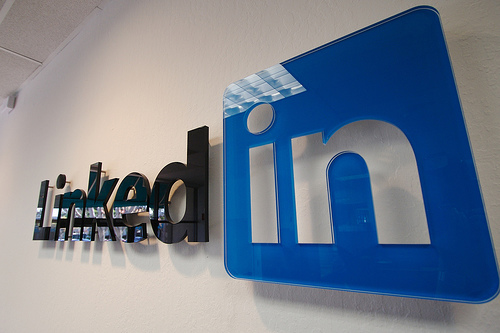
Shares of LinkedIn popped in after-hours trading Thursday, after the professional network reported first-quarter results that handily beat analysts’ consensus estimates and announced that it’s buying popular document-sharing platform SlideShare.
Late Thursday, LinkedIn reported a profit of $5 million, or 4 cents a share, on revenue that doubled to $188.5 million. On an adjusted basis, earnings came in at 15 cents a share, well above the consensus outlook of 9 cents.
The first-quarter revenue, which topped expectations of $178.8 million, up 91% from the year-ago period, represents the seventh straight quarter LinkedIn has doubled its sales. LinkedIn earned $2.1 million on revenue of $94 million during the same period a year ago.
On the news, LinkedIn (NYSE:LNKD) shares jumped 11% to $109.41 in after-hours trading, after they rose nearly 3% during the day.
“LinkedIn’s solid performance in the first quarter built on the company’s momentum in 2011,” said Jeff Weiner, CEO of LinkedIn, in a release. “We saw strength across all key metrics from member signups and engagement to significant revenue growth across our three product lines.”
The better-than-expected report comes just a year after the company debuted on the NYSE where it saw its shares doubled from their IPO price of $45 in the first few hours. The stock has traded as low as $59 a share and as high as $111 since going public.
Future growth through SlideShare
LinkedIn also took the time to announce a deal to buy professional content-sharing site SlideShare for $118.75 million in cash and stock. The deal will include about 45% cash and about 55% stock, and is expected to be completed in the second quarter.
SlideShare, founded in 2006, allows people to share presentations through the Web and is common business meeting tool. Last month Slide Share experienced nearly 29 million unique visitors, according to LinkedIn. And the site has nearly 7.4 million presentations embedded on more than 1.4 million Web domains.
“Presentations are one of the main ways in which professionals capture and share their experiences and knowledge, which in turn helps shape their professional identity,” LinkedIn CEO Jeff Weiner said in a statement. “These presentations also enable professionals to discover new connections and gain the insights they need to become more productive and successful in their careers, aligning perfectly with LinkedIn’s mission and helping us deliver even more value for our members. We’re very excited to welcome the SlideShare team to LinkedIn.”
Previous investors in SlideShare include the venture firm Venrock and a host of angel investors, including Ariel Poler, Yee Lee, Saul Klein, Mark Cuban, Dave McClure, Jonathan Abrams and Hal Varian.
Where LinkedIn revenue is coming from
LinkedIn has been refocusing its efforts for just being a professional social network or high-tech Rolodex to adding in hiring solutions such as its recruiter tools. Revenue from its various hiring solution products hit $102.6 million, an increase of 121% compared to the first quarter of 2011. It’s also key to note that this revenue line represented 54% of total revenue in the first quarter of 2012, compared to 49% in the first quarter of 2011. So not only does this continue to be a big money draw but it is showing signs that it could continue to grow as a money-maker for the company.
This focus on the company hiring products started to really gear up in January, when the company started an early rollout of Talent Pipeline with five charter customers including PepsiCo, Pfizer, Red Hat, Netflix, and First Citizens Bank.
Another arm of the LinkedIn revenue stream is its marketing solution where companies can promote their company brands and products to users of the system. The company’s marketing products totaled $48.0 million, an increase of 73% compared to the first quarter of 2011. Marketing Solutions revenue represented 26% of total revenue in the first quarter of 2012, compared to 30% in the Q1 last year.
And LinkedIn also continues to upsell users to premium subscriptions, which increased 91% year over year to bring in $37.9 million for this past quarter. Premium subscriptions represented 20% of total revenue in the first quarter of 2012, compared to 21% of revenue in the first quarter of 2011.
Revenue from the U.S. totaled $120.8 million, and represented 64% of total revenue in the first quarter of 2012. Revenue from international markets totaled $67.6 million, and represented 36% of total revenue in the first quarter of 2012.
Revenue from the field sales channel totaled $101.5 million, and represented 54% of total revenue in the first quarter of 2012. Revenue from the online, direct sales channel totaled $87.0 million, and represented 46% of total revenue in the first quarter of 2012.
Future outlook
LinkedIn also provided expectations for the second quarter of 2012, stating that revenue should come in between $210 million to $215 million. The company also increased its year-total guidance to hit a revenue expected range of $880 million to $900 million — up from the prior range of $840 million to $860 million.
Whether this jump in estimates is enough to get Wall Street excited is unclear.
At least one analyst believes investors have already priced in significant upside to the company’s performance.
Citigroup analyst Mark Mahaney stated, in an earnings note earlier this week, that the company is “arguably one of the strongest assets arising out of the 2011-2012 ‘Net initial public offering cycle.” But Mahaney maintains a hold rating, stating: “We find current valuation (70X) far from compelling. We would become more constructive on a material share price pullback or on signs of material upside to our estimates, most likely driven by usage and monetization improvements.”




















